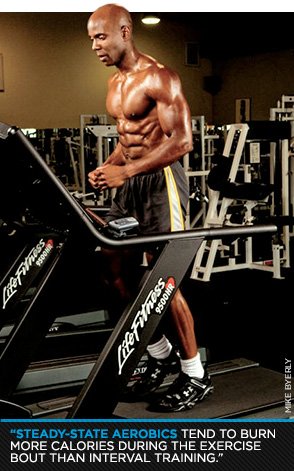I've heard that doing interval training is the best form of cardio, but I don't think I'm ready for all-out sprints. Can I do steady-state cardio instead?
We've all read a billion articles on the benefits of high intensity interval training (HIIT). Heck, I've written a bunch of them! I'm a huge advocate for HIIT cardio, but I also think slow, steady-state cardio has its own respective advantages for fat loss and might be better for certain fitness enthusiasts. Depending on your fitness level, age, experience, and goals, steady-state cardio can definitely serve a purpose in your workout regimen.
Is Steady-State Cardio for Me?
Slower, steady-state cardio is great for people who may not have the endurance, speed, experience, or mobility to do HIIT cardio. It's also great for competitive bodybuilders whose primary concern is building as much muscle as possible. Many competitive bodybuilders prefer walking on a treadmill for their cardiovascular training to avoid any possible muscle loss. Obese, pregnant, or elderly trainees can also benefit from doing steady-state cardio instead of HIIT.

If you're new to the fitness world and aren't sure which cardio style is best, spending 45 minutes on the stationary bike is probably a better starting choice than all-out sprinting. Renowned fitness expert Lyle McDonald explains that steady-state cardio is "more appropriate for beginners" than HIIT.
Steady-state cardio also boasts numerous other advantages. McDonald reasons that, depending on the intensity, "steady-state aerobics tend to burn more calories during the exercise bout than interval training." He also says that, because of the high energy demands and longer recovery times of HIIT, "some research suggests that regular exercise helps people stick to their diet better." In other words, if you're unable or don't want to do HIIT cardio, your fat-loss goals are not invalid!
You can do steady-state cardio on a variety of machines. Often, people find training on the treadmill or stairmill to be tough on their joints. If you have knee, hip, or ankle problems, the elliptical or stationary bike may be a better choice. My advice is to try them all and choose the ones that feel best for your body and efficiently support your fitness goals.
The Fat-Burning Zone
Another advantage to steady-state cardio is the length of time your body is in the fat-burning zone. The fat-burning zone occurs when you work at roughly 65 percent of your maximum heart rate. It happens when your body works hard enough to burn fat, but not too intensely that it switches to sugar for energy. I will say, however, that exercising in the fat-burning zone is not a hard and fast rule. Nobody ever got fat doing sprints.
Don't Hate Steady-State
Moderate-intensity work on an elliptical burns about 10 calories per minute. So, if you choose steady-state for your cardio training, you can still burn significant calories. However, spending an hour on the elliptical each day can be monotonous. I like to switch between HIIT training and steady-state for my cardio workouts. It makes cardio training more enjoyable and helps to prevent plateaus.
References
- Body Recomposition: Steady State and Interval Training: Part 1by Lyle McDonald.2. http://www.livestrong.com/article/539508-60-minutes-steady-cardio-vs-20-minutes-intervals/#ixzz2M8BQqv86


